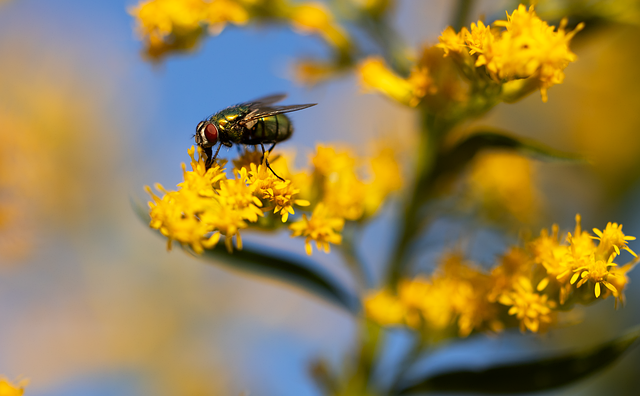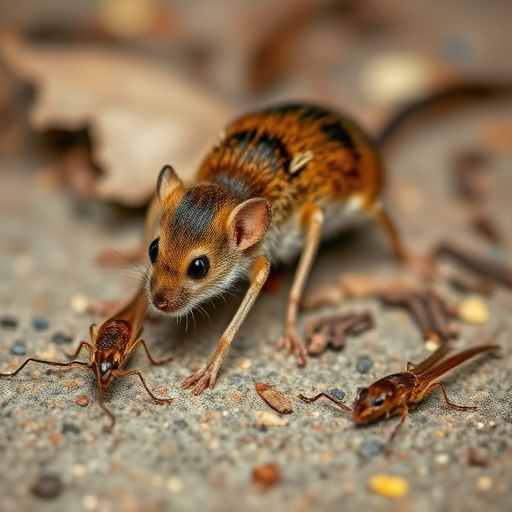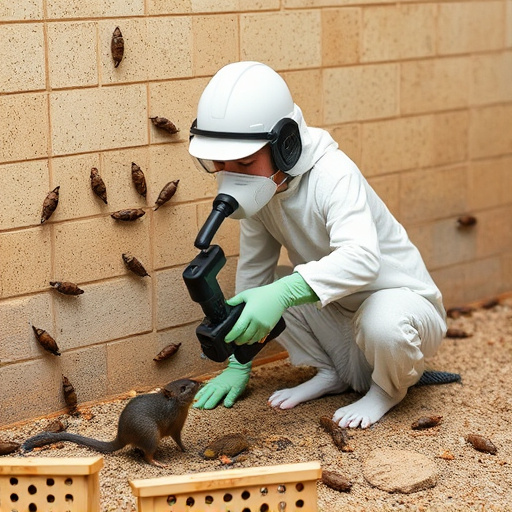Pest Control Services employ a scientifically informed approach, integrating detailed knowledge of pest biology with real-time environmental data to manage pest populations effectively and sustainably. A deep comprehension of pest behavior, including their interactions with the environment and their life cycles, enables targeted strategies that address infestations at their root without excessive reliance on chemical interventions. These services utilize Integrated Pest Management (IPM) techniques, such as barriers to prevent access, sanitation measures, and advanced monitoring systems, to provide long-term solutions that are both environmentally conscious and cost-effective. By closely monitoring environmental indicators, Pest Control Services can proactively mitigate the risk of infestations through innovative methods aligned with sustainable control measures, minimizing ecological disruption and protecting crops, livestock, and human health. The industry's evolution reflects a commitment to adopting cutting-edge technologies and sustainable practices, ensuring that pest management remains both effective and responsible, with a focus on preserving the environment while fulfilling homeowner needs.
Effective pest control requires a nuanced understanding of pest behavior, which is crucial for implementing targeted management strategies. This article delves into the intricacies of pest ecology, highlighting how environmental factors influence their activity and informing the best practices in pest control services. From identifying common pests to exploring advanced techniques like Integrated Pest Management (IPM) approaches, we provide a comprehensive guide for both pest control professionals and homeowners. Additionally, we offer insights into the future of pest control, focusing on innovations and sustainable practices that promise to enhance our ability to manage pest behavior responsibly. Understanding these dynamics is not only key to protecting our environments but also essential for the success of pest control services in safeguarding public health and safety.
- Understanding Pest Behavior: A Key to Effective Pest Control Services
- The Role of Environmental Factors in Pest Activity and Management Strategies by Pest Control Services
- Identifying Common Pests: A Guide for Pest Control Services and Homeowners
- Advanced Techniques in Pest Control Services: Integrated Pest Management (IPM) Approaches
- The Future of Pest Control Services: Innovations and Sustainable Practices in Managing Pest Behavior
Understanding Pest Behavior: A Key to Effective Pest Control Services

Effective pest control services hinge on a profound understanding of pest behavior, which is critical for successful pest management. By closely observing and analyzing how different pests interact with their environment, pest control professionals can devise targeted strategies to mitigate infestations effectively. Knowledge of pest behaviors such as feeding patterns, harborage preferences, and reproductive cycles enables these experts to anticipate pest movements and disrupt their life cycles before populations escalate. This proactive approach minimizes the reliance on chemical treatments and promotes sustainable practices that protect both the environment and public health.
Understanding the behaviors of pests is not a one-size-fits-all endeavor; it requires tailored approaches for each species. For instance, rodents may gnaw on wires and wood to keep their incisors trim, while insects like cockroaches are nocturnal and can squeeze into tiny crevices. Pest control services that leverage this behavioral knowledge can implement a variety of Integrated Pest Management (IPM) tactics, including exclusion methods to prevent entry, sanitation practices to remove attractants, and monitoring devices to detect early signs of an infestation. This comprehensive understanding of pest biology allows for the design of effective, long-term pest control strategies that are both eco-friendly and economical.
The Role of Environmental Factors in Pest Activity and Management Strategies by Pest Control Services

Environmental factors play a pivotal role in the activity patterns and life cycles of pests, influencing their behavior, distribution, and abundance. Factors such as temperature, humidity, available resources, and habitat conditions can significantly affect pest populations. For instance, a favorable climate can accelerate their growth rates and reproduction, leading to outbreaks. Pests are adept at adapting to environmental changes, which makes predicting and managing their activity challenging yet crucial for protecting crops, livestock, and human health.
To effectively manage pest populations, Pest Control Services employ a range of strategic approaches tailored to the specific conditions influencing pest behavior. These services integrate a comprehensive understanding of pest biology with environmental data to design targeted interventions. By monitoring environmental cues that trigger pest activity, such as seasonal changes or weather patterns, these professionals can anticipate and prevent potential infestations. Advanced techniques like integrated pest management (IPM) are often employed, focusing on prevention, monitoring, and the judicious application of controls to ensure long-term sustainability without compromising ecosystem health. Through these efforts, Pest Control Services provide a critical defense against the adverse impacts of pests, safeguarding resources and promoting environmentally sound practices.
Identifying Common Pests: A Guide for Pest Control Services and Homeowners

Understanding pest behavior is paramount for both pest control services and homeowners to effectively manage infestations. Identifying common pests is the first step in any pest management strategy. Pest control services often encounter a variety of invasive species, each with distinct behaviors and habitats. For instance, rodents like mice and rats exhibit chewing behaviors that can lead to property damage, while ants and cockroaches are social insects that can establish colonies within or near homes. Homeowners should be vigilant for signs of these pests, such as droppings, nests, or the sighting of the pests themselves. By recognizing the common pests, both pest control professionals and homeowners can implement targeted strategies to prevent entry, eliminate food sources, and remove hiding places. Effective pest identification is critical; it allows for the selection of appropriate control methods and reduces the risk of misapplication. Pest control services utilize a combination of inspection techniques, monitoring devices, and knowledge of pest biology to detect and manage infestations. This proactive approach ensures that interventions are not only effective but also environmentally responsible and compliant with safety regulations. Homeowners benefit from this expertise by gaining the tools and knowledge necessary to maintain a pest-free living space, thereby safeguarding their health and property.
Advanced Techniques in Pest Control Services: Integrated Pest Management (IPM) Approaches

In recent years, the field of pest control has evolved significantly with the integration of advanced techniques that prioritize ecological balance and long-term sustainability. Among these innovative approaches, Integrated Pest Management (IPM) stands out as a comprehensive framework for effective pest control services. IPM combines biological, cultural, physical, and chemical tools in a strategic manner to manage pests more judiciously. This method involves the careful study of pest behavior, identification, population dynamics, and environmental conditions to implement the most appropriate pest control strategies. By understanding the life cycles and habits of pests, professionals can intervene at critical times, reducing the need for chemical treatments and minimizing the potential for resistance development. This proactive and preventive strategy not only ensures the protection of human health and food safety but also safeguards non-target organisms and the environment. The success of IPM in pest control services is largely due to its adaptability, allowing for tailored solutions that are specific to the unique challenges posed by different pests and settings. It is a forward-thinking approach that continues to evolve with new research and technologies, ensuring that pest management remains effective and environmentally responsible.
Furthermore, the integration of IPM into pest control services has led to significant advancements in monitoring and decision-making processes. Monitoring networks and trapping methods have been refined to provide real-time data on pest populations, enabling precise timing for interventions. This targeted approach reduces unnecessary treatments and minimizes the ecological footprint of pest control activities. Additionally, IPM encourages the use of biological controls, such as introducing natural enemies that are specific to certain pests, thereby reducing reliance on chemical-based solutions. The implementation of IPM in urban, agricultural, and industrial settings has demonstrated its efficacy across a wide range of environments, making it one of the most sustainable and intelligent pest control strategies available today. As such, IPM is not just a set of practices but a philosophy that emphasizes the judicious use of all available tools for pest management, ensuring the best possible outcomes for ecosystem health and human well-being.
The Future of Pest Control Services: Innovations and Sustainable Practices in Managing Pest Behavior

As the field of pest control continues to evolve, innovative technologies and sustainable practices are shaping the future of pest control services. The integration of advanced data analytics with real-time monitoring systems enables more effective predictive strategies for managing pest populations. By analyzing environmental patterns and historical infestation data, professionals can anticipate pest activity and implement preventative measures before an issue arises. This proactive approach not only reduces the risk of damage to crops or structures but also minimizes the need for chemical interventions, promoting environmental health and safety.
Moreover, there is a growing emphasis on sustainable and eco-friendly methods within pest control services. Biological pest management, such as introducing natural predators or using botanical insecticides, is becoming increasingly popular. These methods align with the broader environmental goals of reducing chemical dependency and mitigating the ecological footprint of pest control practices. Additionally, the development of genetically modified organisms (GMOs) resistant to certain pests holds promise for future agriculture sustainability. These advancements in the pest control sector underscore a commitment to harmonizing human needs with the natural balance, ensuring that the management of pest behavior remains both effective and environmentally conscious.
Effective pest control requires a deep understanding of pest behavior, environmental influences, and innovative management strategies. This article has outlined the critical role that education on pest behavior plays in enhancing the capabilities of pest control services. By recognizing how environmental factors impact pest activity, professionals can develop tailored approaches to manage these challenges effectively. Homeowners and pest control services alike benefit from identifying common pests accurately, ensuring the right measures are taken at the right time. Advanced techniques like Integrated Pest Management (IPM) offer sustainable solutions that protect both ecosystems and human health. As we look ahead, the future of pest control services promises even more sophisticated tools and practices, setting a new standard for effective pest management in an ever-evolving environment. With ongoing education and technological advancements, pest control services are poised to meet the challenges posed by pests with greater efficiency and environmental stewardship.



